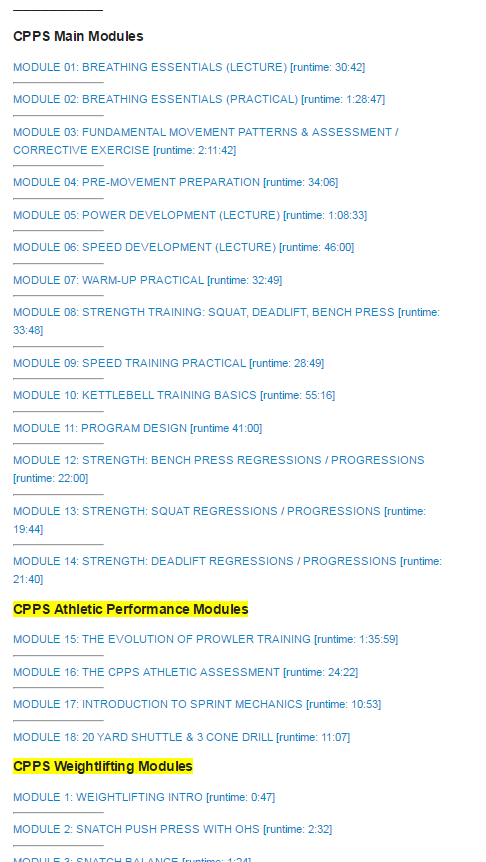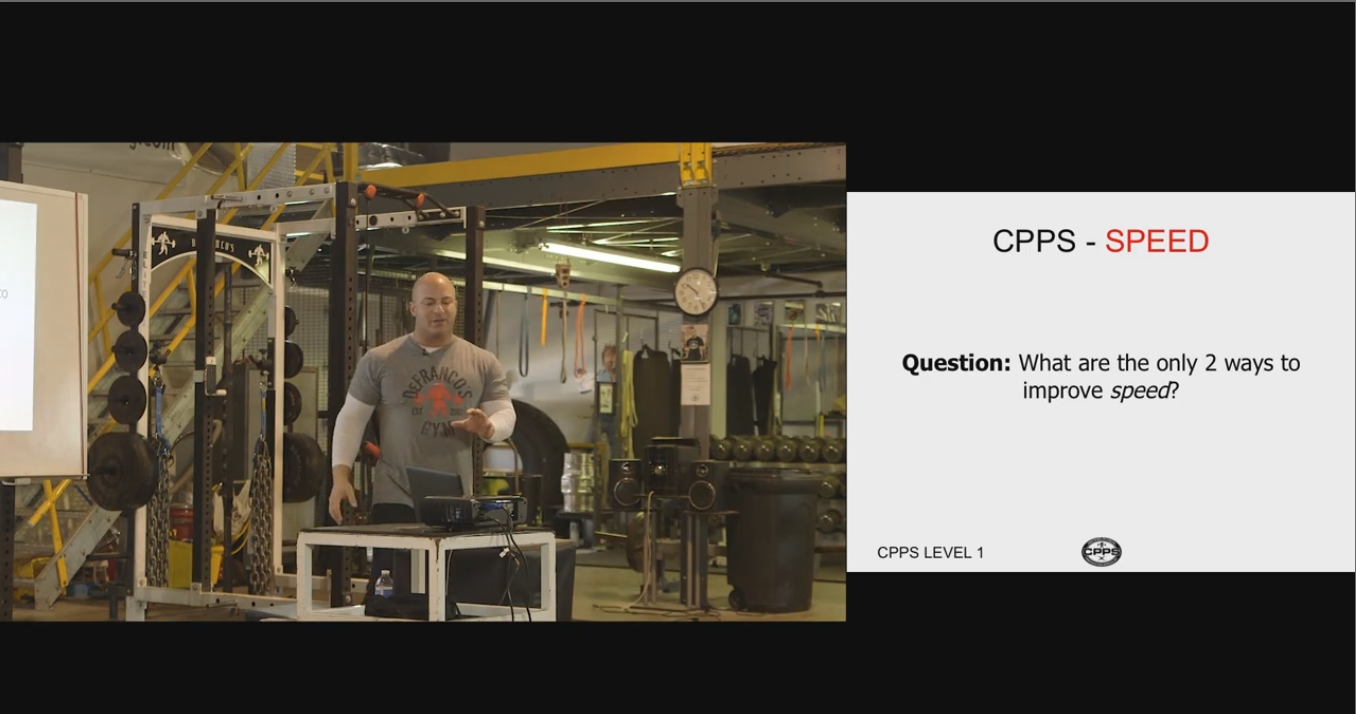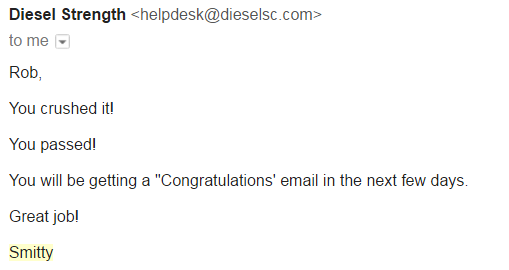Intro:
I recently completed my Level 1 CPPS Coaches certification, created by strength and performance industry leaders, Joe Defranco and Jim Smith. I opted for the online course, as it allowed me more time and flexibility to complete the training. Surprisingly, I haven’t been able to find any reviews on the certification, outside of the CPPS onsite testimonials. Assuming my Google Fu is as strong as I think it is, and there truly aren’t any existing reviews on the web, I’m delighted to write the first.
I readily admit that I’m a total Joe D and Smitty fanboy…my wife says I have a man crush (she’s just jealous that I haven’t paid her $997 to lecture me for 13+ hours). I started following Joe Defranco first, back in 2015. I had heard of him prior (read a couple of his T-Nation articles and tried some of his complexes a buddy gave me from Built Like a Badass), but I didn’t pay too much attention to his work until I heard WWE legend, Triple H (also one of Defranco’s clients), lauding his expertise on a Tim Ferriss podcast.
Immediately following, I found the “Limber 11” mobility routine on YouTube, and became a fan instantaneously. Not much longer, I joined the Defranco Insider and was introduced to Jim Smith (or “Smitty”), Joe’s partner in crime, and accomplished strength coach of his own merit (check out Diesel Strength and Conditioning).
Side note: notice that the $997 I spent on the CPPS certification, and the $20/month I spend on my DefrancoInsider.com membership was the direct result of a free video that I watched on Joe D’s channel over two years ago. Anyone who says putting out free content is a failing endeavor is an archaically-minded, short-sighted fool.
So, we’ve established that marketing with free content turns a profit, and that Joe D and Smitty have evidently mastered the art (at least enough to shake some bills out of me). We’ve also established that having not read a single review on the course (I don’t normally buy anything without first reading a dozen reviews), I took a gamble by dropping a grand on it.
Was it worth it?
Short answer: yep, sure was.
Long answer: keep reading…
Cost:
Online course: $997 (the live weekend seminar is $1197).
Presentation and Delivery:
The course is comprised almost entirely of video modules (accessible from your online member dashboard) which are broken down as follows:
- 14 video lectures and practicums filmed during a live weekend seminar.
- ~11 hours
- 4 videos that go into further detail on assessments, training-specific drills and warm-ups, and prowler/sled training.
- ~2.5 hours
- 19 videos that cover extended exercise mechanics (e.g., hang power snatch, power clean and front squat, etc).
- ~30 minutes
In addition, there are PDFs that feature a syllabus and course notes, as well as links to supplemental Industrial Strength Podcast episodes
Testing method:
You earn your certification upon completing the following:
- Online exam comprised of 120 multiple choice questions and 4 essay questions.
- Video submission exam where you film yourself coaching a client/athlete through 7 different movement progressions.
What you get with the certification (other than lots of knowledge):
- Recognition as a coach in the national CPPS coach & trainer directory (I still need to do this…thanks for reminding me, me).
- Membership to the private “CPPS Coaches” Facebook group.
- Permission to display the CPPS seal commercially.
Thoughts and Impressions:
Thoughts on cost:
One thousand dollars is a lot of money for a small-time personal trainer to spend on information, which is essentially what I bought. On the other hand, it’s really not.
I’m a member of 10,000 different fitness newsletters and publications, and see ads and offers for similarly structured courses and seminars all the time. They’re all comparably priced (some are less, and some are much much more). $1000 +/- is the going rate. My ACE Personal Trainer certification was $400, and all that really got me was a certificate and access to take the test (I took the cheap route, bought used books on Amazon for $40 and went through the material on my own time).
Fitness certifications and courses have been available online for a little while, but have only picked up traction in the last couple years. When you explore a more mature market, like IT online courses, $1000 is chump change. I’ve taken IT courses online for over $4000 (on my former employer’s dime, of course), and in terms of raw, usable information, they didn’t give me any more value than I got from CPPS.
In short, $1000 is just the cost of premium information these days. If you don’t like it, I suggest you get really really good at reading really good books (not a bad idea regardless)…you can start with the suggested reading list Joe and Smitty give you during the lectures ;).
Thoughts on the presentation and delivery:
As mentioned, the entire course is served through an online dashboard, primarily consisting of video modules. Nothing particularly groundbreaking here in terms of format. I’ve participated in several online webinars over the years and got about what I expected; a presenter (Joe, Smitty, or one of the guests) giving a lecture to the group participants, coupled with a super-imposed Powerpoint presentation to highlight the big ticket points.
While the format was pretty standard, the quality was excellent. I’m not sure how many high-def cameras and microphones they had capturing the fun, but it was enough to make me feel like I didn’t miss much. They did a great job capturing some the nuances that may have been absent had there only been one perspective, especially during the practicums. During these times, all the participants split up for 5-45 minutes to work through the action items taken from the lecture. This may sound like video filler, but I truly got as much from these moments as I did from the meat and potatoes of the presentations.
During the practicums, I took the opportunity to work through the on screen tasks as well (whether it was swinging a kettlebell or mobilizing a hip joint). I don’t believe they actually suggest that you try the drills at home, but it’s probably implied (better than sitting in your chair like a goon, watching a bunch of other people work).
I only had one real issue with the videos, and I believe it’s no longer a concern. It was nearly impossible to skip around sections of the videos more than a couple times without the player crashing or timing out. This was consistent behavior across three separate computers and networks. I just about chucked my laptop out the window when I was taking the test, and trying to find answers in the lectures. As mentioned, however, they seem to have corrected it; halfway through the test, the videos started playing with a new embedded player, and I never had the issue again.
It’s also worth noting that Smitty is very responsive in assisting with questions and issues. I reached out to him on a couple different occasions, and received thorough answers on the same day–no complaints on service.
Thoughts on the test:
I’m a pretty solid test taker, and have what I believe to be better than average retention for information. I’m also a meticulous note taker, especially when it comes to a course I spent $1000 on. I took 7741 words worth of notes (just checked the word count) that included time stamps to mark topic discussions in the videos. I also took a screenshot of every slide they presented. I went to these great lengths because the test was open-note with an indefinite time limit, and I wanted to make sure I crushed it.
All that considered, I only scored an 84% on the multiple choice (needed a 70% to pass). To put that into perspective, I scored a 93% on my ACE personal trainer certification, which was a closed book grind against the clock.
The multiple choice part of this test was brutal. I mean–really–they make you earn it. Half of the questions were those horrible bastards that make you “choose all that apply”, or worse, choose the three that are the best, when all of them look pretty good…I may be exaggerating, but only a little.
The difficulty wasn’t very consistent. There were some parts that I totally breezed through; they matched my notes almost to the letter (mostly stuff from Joe’s presentations). There were other parts that I had to do research outside of the course content just to take a shot at the answer, which I probably missed anyway (mostly stuff from Smitty’s material). That’s not to say that either of them was superior to the other (they were both great)…I think Smitty’s just a bigger ball buster (wouldn’t have guessed it).
It was almost as if there were questions on the test that weren’t covered in the online material. I know that’s a heck of an accusation, and I apologize profusely if that’s not the case, but, man, it was tough. Regardless, make sure you take copious notes, and pay close attention to every word in preparation for the multiple choice.
The essay questions were solid. They definitely demanded a lot of thought, but they were very fair; a comprehensive reflection of everything taught in the course.
The video submissions were a great touch. The obvious downside to not being able to attend the CPPS course in person (other than not getting to B.S. with a bunch of like-minded meatheads and smell protein farts all day…a dream vacation), is you don’t get real-time validation on your coaching technique. The video submission requirement was a nice compromise. I filmed myself coaching a client through the seven required videos, uploaded them to YouTube and received a big thumbs up from Smitty within 24 hours.
I know I sound like a whiny punk, complaining about the difficulties of the test, but all things considered, I’m glad it was hard. It forced me to review all the gold and diamonds the course offered in greater detail.
Thoughts on the content and value:
I mentioned my ACE Personal Trainer certification earlier. I’m glad I took the time to get it; it earned me a great deal on trainer insurance, and got me in the door at two local gyms. It also taught a me a lot about physiology and scope of practice (I’ll review the ACE cert some time as well). While the ACE certification definitely goes over assessments, programming and client interaction in great detail, it doesn’t really offer it in a way that you can easily unpack and plug in. Also, a lot of the information isn’t terribly practical. Don’t get me wrong, ACE does a great job vetting all their content and instruction with research out the wazoo, but it lacks bite.
I got everything out of my CPPS certification that I didn’t get from ACE, but it’s really not fair to compare them–they aren’t really in the same vertical. Certifications like ACE, ACSM and NASM teach you how to be a personal trainer. CPPS teaches you how to train your clients and athletes.
On one hand, it gives you a model that you can fall back on. By the end of the course, you know how to assess your clients, look for mobility restrictions and faulty movement patterns (and start down the right path to correct them), progress and regress a bevy of exercises (loaded and unloaded), and program workouts using the CPPS blueprint to help your clients reach their goals.
It’s definitely geared toward coaches and trainers who train athletes, but it’s by no means limited as such. At the moment, I’m managing 23 individual clients in my training practice. Not one of them plays an organized sport, but they’ve all experienced positive results since I’ve applied CPPS fundamentals to their training.
There’s a lot less guess work and fudge in my programming now. It’s much easier to streamline the process. I know where to plug mobility and stability exercises; power, speed and skill work; strength and hypertrophy training; and conditioning and recovery because it was all covered in a tight takeaway format.
That’s not to say that any of it is boilerplate. You get a framework and the tools you need to start putting it together in your practice, but there’s zero restriction on application possibilities. Whether I want to use barbells and sleds to help NFL ballers murder each other, or use body weight exercises and resistance bands to help grandmas become GILFs (Grandmothers I Want to Friend…on Facebook), I can use the CPPS model make it happen.
It’s also very apparent that Joe and Smitty eat their own dog food. I’ve been a member of the Defranco Insider for about a year now, and have closely examined dozens of their workouts and programs (including workouts they’ve created for their professional athletes, as well as the heralded Strong Bastard 911 program), and every one of them is clearly built using CPPS methodology.
Yeh, you could spend $20 on the Defranco Insider for a month, download all the programs and exercises and reverse engineer the system, but are you really going to? Do you know how much time that would take and how much uncertainty you’d be risking? I have a pretty good idea because I considered doing exactly that before finally dropping my loot on the certification proper.
As far as the tangible takeaways from the certification, they’re not too bad.
There’s a ton of good information and networking potential on the CPPS private Facebook group, though I’m personally a lot more active on the Defranco Insider group (working on bumping up my participation in the former).
The credibility of the certification itself has been mixed for me. On one hand, the two people from my small town who have actually heard of it were absolutely ecstatic when they found out I had it. Everyone else doesn’t care what certifications I have…they just want me to tell them what to do. Joe and Smitty both carry a huge amount of clout in the industry, and CPPS’ reputation as a solid program isn’t going anywhere but up. Depending on your market, it may mean something to someone; it may not. Regardless, you’ll be better at your craft.
The only downside I’ve found is that it isn’t recognized as a continuing education credit in my ACE certification. I don’t know who I need to take that up with, but there are about 100 fly-by-night certifications that made the cut. It would be nice to benefit doubly from my investment, but I guess I don’t need icing on my cake.
Conclusion:
I really didn’t know what I was going to get with this certification (again, there aren’t any other freakin’ reviews out there!). I loved Joe and Smitty’s free material, and that they seemed genuinely enthusiastic every time they plugged CPPS on their media outlets. There was, however, in the corner of my mind, a chance that maybe they just thought it was great, and everyone else just enjoyed the taste of their Kool-Aid. Or, that the course was full of great information, but I’d have to sift through a tangled mess to find it. I’m glad I didn’t listen to the corner of my mind.
I took a $997 gamble on the product, and though soft cost ROI is almost impossible to measure, I have no regrets. In fact, I think it’s already paid off. If you’re a trainer who wants a system you can use to grow your clients into whatever it is they want to be, I suggest you enroll in the CPPS online course next time it’s offered.
Visit the site below to sign up for a free 92 page issue of MASS Research Review (check out my MASS review here) covering the following topics:
- Blood Flow Restriction Training Causes Type I Fiber Hypertrophy in Powerlifters
- Leave the Gym with a Little Left in the Tank
- Energy Availability in Strength and Power Athletes
- Hormonal Contraceptives Don’t Mitigate Strength Gains
- Power Training or Speed Work for Some, But Not All?
- The Role of Physical Activity in Appetite and Weight Control
- The Science of Muscle Memory
- VIDEO: Program Troubleshooting
- VIDEO Sustainable Motivation for Sport and Fitness




